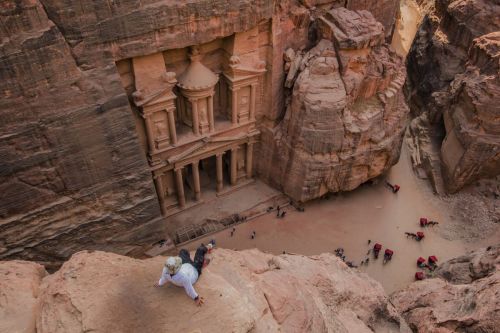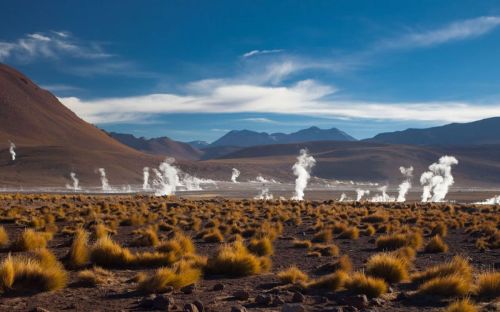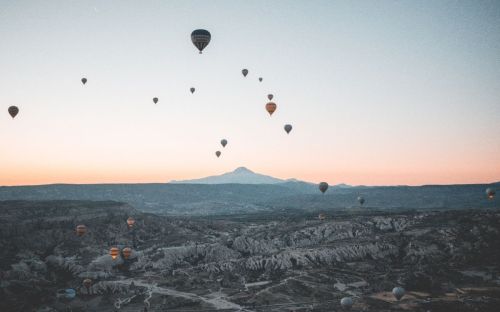Wadi Rum is located in the southernmost part of Jordan, within the boundaries of the Arabian desert of Hisma. It is an animate and inanimate nature reserve. A huge plateau with giant rock formations of unusual colors, undulating red dunes and a starry sky above create a truly fairy-tale scenery.
Since the 1990s, the desert has become a very attractive tourist area, where mountain climbing, sleeping under the stars and riding Arabian horses lure the adventurous.
Wadi is a traditional Arabic term for a valley. The term can also refer to a wet (ephemeral) riverbed that contains water only during heavy rains.
Wadis are located on gently sloping, almost flat parts of the desert. The water that appears in them periodically leaves sediment dams on which wind-borne material then settles, forming sedimentary structures. Wadi sediments can contain a range of materials, from gravel to mud - they are the most diverse of all desert environments.
Unlike canyons, gullies, and dry riverbeds, wadis are generally dry throughout the year, except after rain. Desert environments are characterized by sudden but infrequent torrential rains, which often cause flash floods (being in a wadi during such a period can be dangerous).
The Wadi is situated 250 kilometers south of Jordan's capital, Amman, and 70 kilometers north of the coastal city of Aqaba, near the Jordanian-Saudi border.
It is located within the boundaries of the Hisma Desert, a sandy desert on the Arabian Peninsula that is one of the most beautiful deserts in the world. Its rocky mountains are characterized by their white, yellow, red and brown colors and distinctive geographic formations.
The Hisma Desert is an important place in human history because it was home to the Nabataeans (an ancient people of Semitic origin who arrived from the Arabian Peninsula in what is now southern Israel and southern Jordan around the 6th century BC) and other Arab tribes who, before the Nabataeans, left inscriptions in an Arabic dialect known as the Hismaic dialect.
These include Jabal Umm ad Dami, Jabal Ramm and Jabal um Ishrin.
Jabal Umm ad Dami is Jordan's highest peak, at 1840 meters above sea level, and is located 30 kilometers south of the village of Wadi Rum. On a clear day, you can see the Red Sea and the border with Saudi Arabia from its summit. There is an astronomical observatory at the top.
Jordan's second highest peak is Jabal Ramm (1,734 meters above sea level), one meter lower is Jabal um Ishrin. The east face of Jabal Ramm is considered one of the greatest climbing attractions in the region.
People settled in Wadi Rum thousands of years ago and struggled to survive in the harsh environment. They were hunters, shepherds, farmers and traders. It was once inhabited by the Nabataeans, who left behind many buildings and inscriptions, including a temple known today as the "Nabataean Temple".
He called it Aramava in his list of cities in Arabia, indicating that the valley was at a point tangentially connected to the Nabataean economic centers of Petra and Ayla.
In the 1990s, researchers conducted studies of the valley, including the reconstruction of its ruins. These studies revealed the presence of a complex of palaces and baths dating back to the Nabataean period.
Former residents of the valley joined the forces of the Great Arab Revolt under King Faisal and fought alongside Thomas Edward Lawrence (Lawrence of Arabia) during the Great Arab Revolt of 1916.
He crossed the valley several times during the Arab Revolt of 1917-18 and eventually settled there. During the revolt, he advised the rebels on the battlefield. In order to influence them more easily, he adopted their dress and customs and tried to outdo them in endurance for the hardships of travel and courage in battle. As a result, many fighters recognized him as their leader. He avoided giving orders and tried to influence the local chief to give his orders to the soldiers.
He was in direct command only of his mercenary guard, which by the end of the conflict numbered about 90 warriors.
Until recently, they led a nomadic lifestyle of goat and camel herding, and although some now live in modern concrete houses, they still maintain Bedouin customs and Arab traditions, including weaving tents from goat hair.
The Bedouins of Wadi Rum are extremely hospitable and are largely responsible for the development of the valley as a tourist destination. Many tourists consider sharing a meal or coffee with a Bedouin as one of the best memories of a trip to Wadi Rum.
At that time, a large crack in the earth's crust formed, resulting in the creation of Wadi Rum, in addition to the Jordan Valley and the Red Sea. Wadi Rum is considered one of the most beautiful deserts in the world. Its rocky mountains are characterized by their white, yellow and red colors and distinctive formations.
The area is a reserve where only about 200 square kilometers are dedicated to any human activity, while the rest (about 520 square kilometers) is left undisturbed. It combines various terrains, including a group of mountains, plateaus, narrow valleys, natural arches and high cliffs.
One is on the southern side, near Wadi Al-Yatm, and the other is on the northern side. There are many remnants of the Nabatean civilization in the Wadi Rum area, including the Nabatean temple near Mount Rum, and sites that were used as lookouts for trade convoys to protect them from attack.












